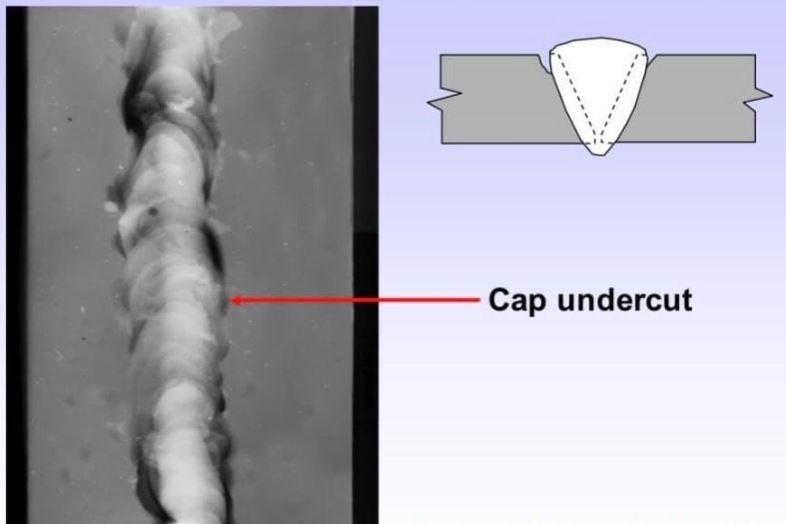Best Guide to Preventing Weld Undercut: Tips and Techniques
Best Guide to Preventing Weld Undercut: Tips and Techniques
Blog Article
Comprehending the Causes and Solutions for Undercut Welding in Metal Fabrication Procedures
In the world of metal manufacture procedures, the event of undercut welding poses a substantial challenge that requires a detailed understanding of its causes and sensible options. The elaborate interaction of various factors during welding procedures can lead to this undesirable phenomenon, affecting the structural honesty and overall top quality of the bonded joints - Preventing weld undercut. By dissecting the origin creates of undercut welding and discovering effective restorative steps, makers can elevate the requirement of their workmanship and ensure the manufacturing of perfect steel components
Common Root Causes Of Undercut Welding
Regularly forgotten in steel construction, undercut welding takes place as a result of various factors that require careful interest and experience to be properly minimized. One typical reason for undercut welding is excessive heat input. When the warmth input is too expensive, it can result in the melting and subsequent disintegration of the base material along the sides of the weld joint, developing a groove or undercut. Furthermore, improper welding techniques, such as using the wrong welding angle or travel speed, can likewise add to undercut formation. Insufficient shielding gas coverage is one more key aspect that can result in damaging. Inadequate gas protection falls short to safeguard the weld pool effectively, causing oxidation and undercut defects. The option of welding parameters, such as voltage, present, and cord feed speed, plays a considerable duty in the occurrence of undercut welding. Comprehending these common reasons is crucial for carrying out safety nets and ensuring premium welds in steel fabrication processes.
Impact of Incorrect Welding Parameters
Unreliable welding specifications can considerably endanger the integrity and quality of bonded joints in steel manufacture processes. The impact of inaccurate welding specifications shows up in numerous means, leading to structural weaknesses and flaws in the bonded parts. Thorough focus to welding criteria is paramount to guarantee the production of top notch welds with the wanted mechanical properties and structural integrity.
Effect of Improper Lantern Angle
Improper lantern angle in welding operations can significantly influence the high quality and integrity of the last weld joints in steel fabrication procedures. Damaging is a common welding issue where a groove develops along the weld toe, weakening the joint and endangering its structural integrity.
A torch angle that is too high can lead to inadequate penetration, incomplete blend, and enhanced spatter. On the other hand, a lantern angle that is too superficial can cause extreme infiltration, burn-through, and distortion of the base material. Preventing weld undercut. Appropriate lantern angle is important for making certain regular weld quality, stamina, and look
To avoid damaging and various other problems triggered by inappropriate torch angles, welders must be trained to preserve the correct lantern angle throughout the welding procedure. Routine surveillance and change of torch angles during welding can assist attain sound welds with very little issues.
Function of Inadequate Welding Methods

An additional element of poor welding techniques is improper weld preparation. Insufficient cleansing of the base steels, wrong joint layout, or insufficient edge preparation can all contribute to damage welding. Inadequate shielding gas coverage or using the wrong type of gas can result in incomplete blend and the development of undercut issues.
To resolve the duty of poor welding strategies in metal fabrication procedures, it is essential to provide thorough training for welders. Correct education and learning on welding specifications, joint preparation, and shielding gas option can aid avoid undercut welding and guarantee top quality welds in metal manufacture jobs.
Efficient Solutions for Undercut Welding
Addressing undercut welding in steel construction requires implementing reliable options to boost weld high quality and structural why not look here honesty. One of the primary remedies to fight undercut is to adjust welding criteria such as voltage, present, and take a trip speed to ensure proper warmth input and combination. By fine-tuning these setups, welders can stop excessive melting of the base steel and filler material, lowering the possibility of undercut development.
Additionally, correct joint prep work is important in preventing undercut. Making sure clean base metal surface areas totally free of impurities and using the proper bevel angle can help advertise far better weld infiltration and decrease the danger of undercut - Preventing weld undercut. Employing appropriate welding strategies, such as weaving or oscillating the torch, can additionally aid in distributing warm equally and filling the weld joint appropriately, decreasing the opportunity of useful content undercut defects
Furthermore, picking check out this site the correct welding consumables, including electrodes and filler metals, is crucial in alleviating undercut. Using products with appropriate chemical structures and mechanical buildings can add to achieving audio welds with marginal undercut. Routine evaluation and quality assurance steps ought to additionally be applied to spot and address undercut problems quickly, making certain the total stability of produced metal elements.

Conclusion
To conclude, understanding the reasons and solutions for undercut welding in steel construction processes is essential for achieving high-quality welds. By resolving typical causes such as inaccurate welding parameters, improper lantern angle, and inadequate welding methods, welders can avoid damaging and make sure solid, resilient welds. It is important to take notice of these aspects and execute effective remedies to enhance the general welding process and final item quality.

Report this page